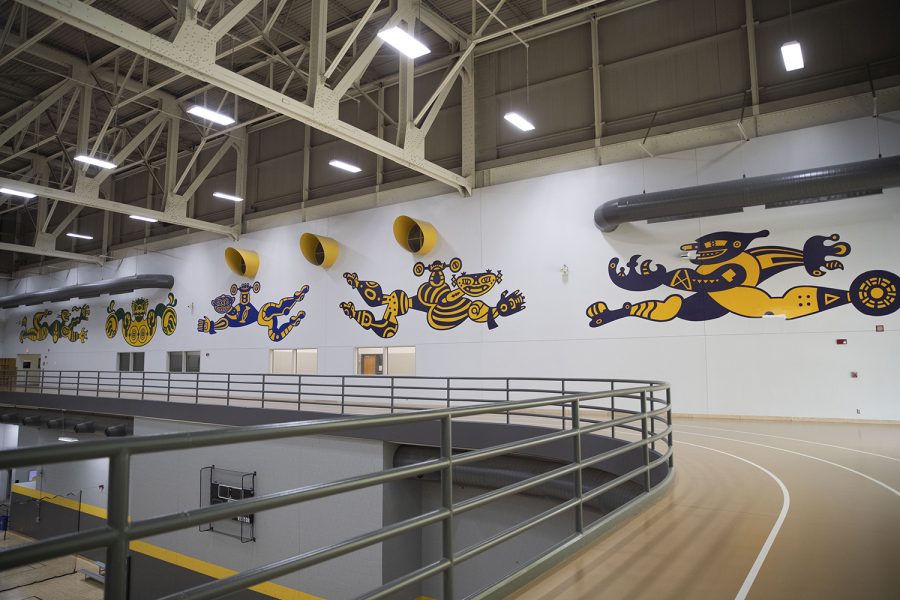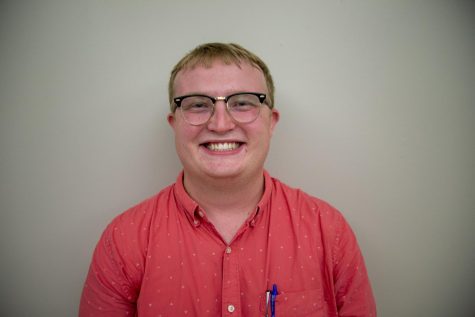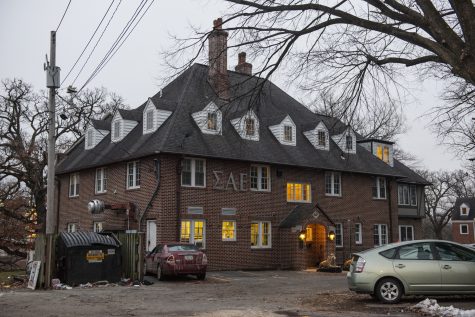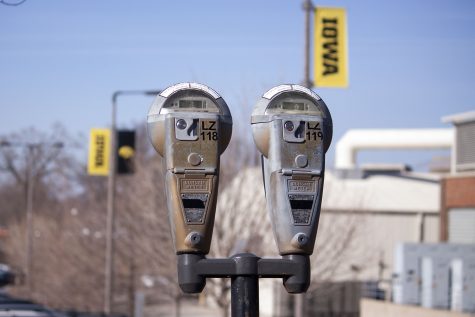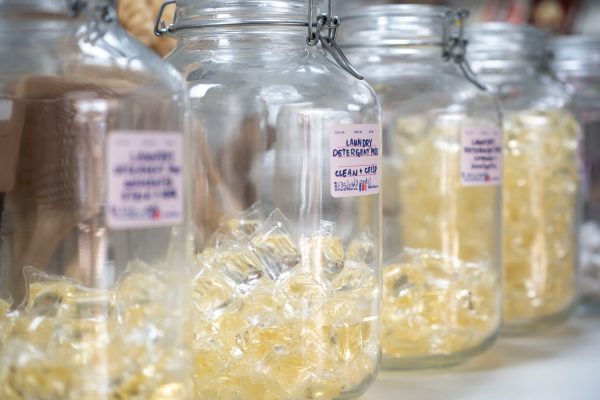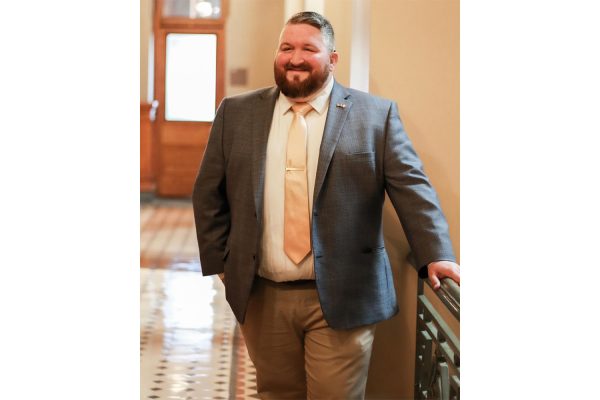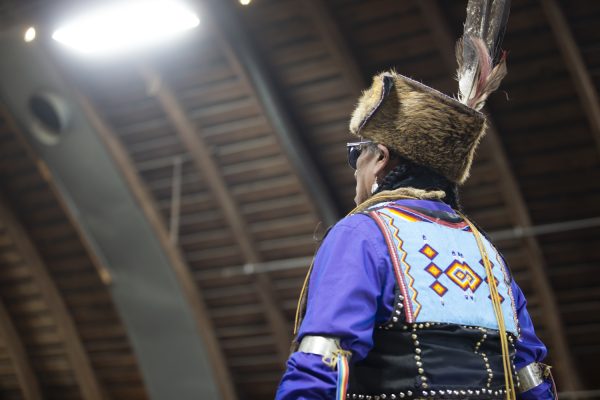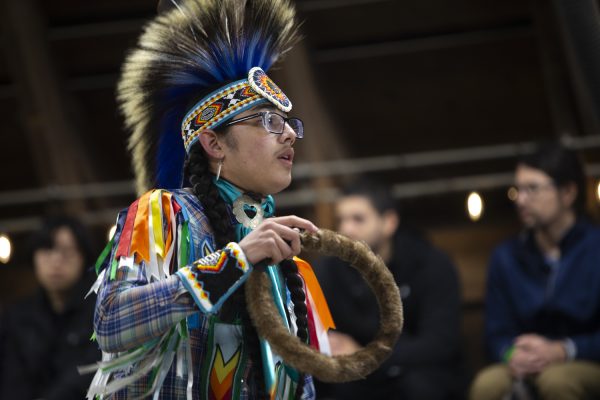A mural mystery: The story of Karl Wirsum and the Iowa Field House
Years after Iowa Athletics moved out of the building, 10 paintings by Chicago-area artist Karl Wirsum were commissioned for the Field House track.
A mural is seen inside The University of Iowa Field House building in Iowa City on Feb. 21, 2022. The mural can be seen from the fourth floor track or the first floor courts.
February 22, 2022
Ten mysterious and odd-looking figures have occupied the University of Iowa Field House since 1996.
They’re not Iowa Athletics staffers, coaches, or athletes that got lost in the shuffle when Hawkeye sports like men’s wrestling and men’s and women’s basketball moved from the Field House to the then-newly constructed Carver-Hawkeye Arena in 1983.
The figures aren’t Iowa swimmers or divers that couldn’t find their way to the $69.2 million Campus Recreation and Wellness Center in 2010, either.
The brightly colored, 8.5-foot humanoids are actually part of Chicago-area artist’s Karl Wirsum’s “Just Us What Past Before Us” mural.
All the wall-painted images depict people taking a number of athletic poses around the Field House’s fourth-floor track.
Wirsum’s humanoids have been described as “alien, robotic, and superheroic.”
“[The murals are] a little creepy,” said Jaymeson Harms, a frequent Field House user and first-year history education student. “Every day you walk in and see and it’s like, ‘What’s the point of those?’”
Derek Eller, who owns an art gallery in New York that bears his own name, said Wirsum’s “pop art” draws upon a number of styles like comic book strips, advertising, oceanic and South American art, and European surrealism.
“Karl was heavily influenced by blues music,” Eller said. “So, [his art] is this weird amalgamations resynthesis of all these different influences, which sort of give it its quirky flavor. What he was really doing for decades was this simultaneous exploration of figuration and abstraction. You have these sort of characters that are essentially made up of all these geometric forms.”
Eller’s gallery has featured works from Wirsum since 2010. Eller said Wirsum’s regular works of art can sell for $30,000 to $65,000. The artist’s more historical and famous pieces can draw up to $200,000 at auctions.
According to a UI Museum of Arts commission file, Wirsum’s art in the Field House cost $49,600.
Pamela White, who served as UI Museum of Arts director from 2008-10, said the murals in the Field House were designed by Wirsum and executed by sign painters via scaffolding.
Commission file documents indicate that Stephen Prokopoff, who was UIMA director from 1992-2000, brought Wirsum’s work to Iowa City.
In an email exchange with The Daily Iowan, White said Prokopoff was a fan and friend of Chicago-area imagists like Ed Paschke. Prokopoff’s connection to Chicago-based artists led him to bring in Wirsum.
When “Just Us What Past Before Us” was commissioned in 1996, Prokopoff said the collection would not have existed had the Iowa Legislature not released new rules for art in public buildings in 1978.
Prokopoff died of non-Hodgkin’s Lymphoma in 2001.
The Iowa Legislature repealed the Art in State Buildings program in July 2017. The UI, however, retained and continues to display the collection of artwork it acquired through the program
The UI Field House is hardly the first building Wirsum changed with art.
Wirsum was part of a Chicago-based art group called “The Hairy Who” in the 1960s. Wirsum, Jim Falconer, Art Green, Gladys Nilsson, Jim Nutt, and Suellen Rocca were the group’s six members — all of whom attended the Art Institute of Chicago.
Per the Art Institute of Chicago’s website, The Hairy Who revitalized the art scene in Chicago by mounting “unconventional displays of bright, bold graphic work” on the city’s south side.
The future of Wirsum’s legacy
Eller said Wirsum’s art career began with an injury he sustained as a child.
Wirsum was supposedly talking to his mom from the top of the basement stairs at his childhood home. Wirsum leaned further and further through the doorway to hear what his mother was trying to tell him as she did laundry.
A young Wirsum then fell down the steps and fractured his skull. The injury hospitalized him.
As he was recovering, he read daily comic strips about gnomes and elves that his father penned. Wirsum’s dad, August, was an amateur artist. August drew and sketched with Karl while he was in the hospital with his head injury.
Eller believes August’s background in comics influenced the art that Karl created during his 81-year lifetime.
Karl’s parents died in a car accident in 1949. The then-10-year-old Karl Wirsum was in the car when his parents collided with a tractor-trailer truck, per The Chicago Tribune. Wirsum survived the accident with minor injuries — his parents did not.
“There’s been speculation that, in a way, his work always retained a sort of childlike quality because of some of the traumatic events that happened to him as a child,” Eller said. “He still sort of stayed in the playful, childlike sort of spirit of the cartooning that was happening when he was younger.”
Karl Wirsum, himself, died of cardiac arrest at the age of 81 at Advocate Illinois Masonic Medical Center on May 6, 2021, according to The Chicago Tribune.
Wirsum’s art will help memorialize him in places like the Art Institute of Chicago and Eller’s gallery.
His murals in the UI Field House, however, may only do so for a few more years.
On Jan. 12, the UI announced that it will execute a Board of Regents-approved 10-year facilities master plan. The blueprint includes a new ambulatory care center for UI Hospitals and Clinics.
Per a release, the ambulatory care center will be built on the ground that is currently occupied by the 95-year-old Field House, throwing the murals’ status into question.
However, UI senior vice president of finance and operations and university architect Rod Lehnertz told The Daily Iowan that some parts of the plan may change as it unfolds in the coming years.
“It is too early to define a specific course of action regarding the murals,” Lehnertz said in a statement prepared for The Daily Iowan. “As more is known regarding plans, funding, and schedules, we will certainly work closely with our director of the Stanley Museum of Art and others to ensure appropriate protection or recognition of the paintings that were done in the Field House.”
No matter how the murals are recognized or preserved, Eller believes all of Wirsum’s art will serve as inspiration for up-and-coming creatives.
“I think there are generations of artists that will cite [Wirsum] as a major influence,” Eller said. “He’s been one of these underappreciated, undervalued artists for many years . . . I think there are many famous contemporary artists that will cite Karl as an input.”
“I feel like his legacy will only grow and strengthen in the coming years as more institutions and exhibitions include him,” Eller added. “People will realize that he really offered something quite special that other people have learned from and taken from.”



